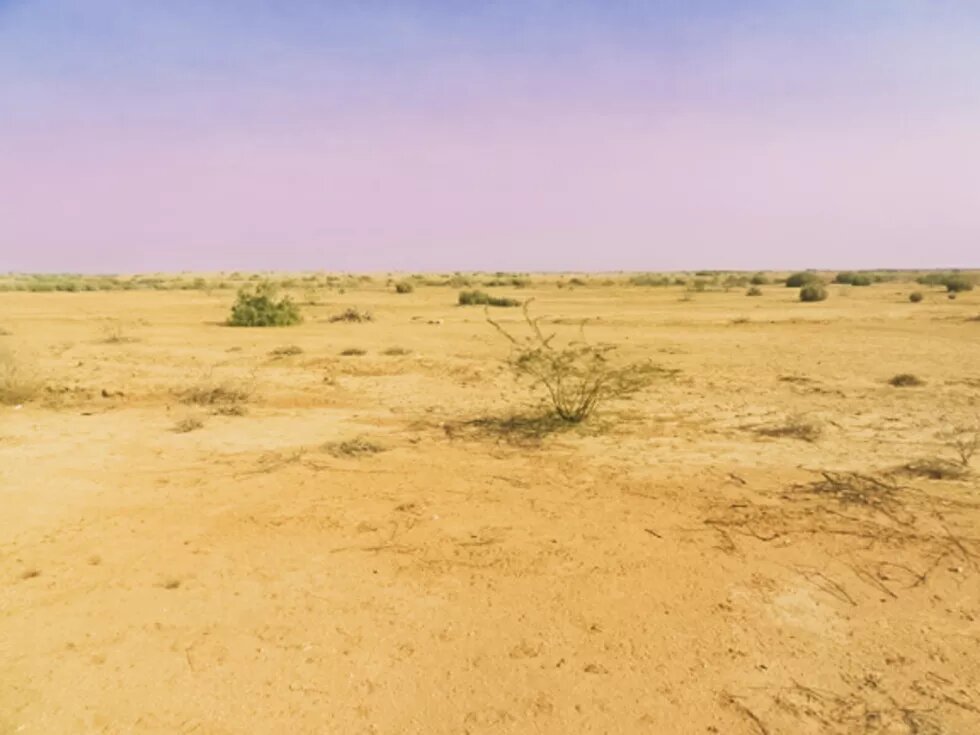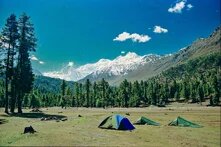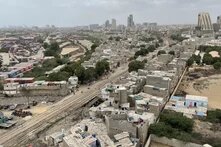
Successful green energy initiative transforms Pakistan's remote region into a thriving town.

Only a two-hour drive from Pakistan's port city of Karachi, the hilly town of Jhimpir is famous for its red stones. However, the remote site in southern Pakistan had long remained largely uninhabited and swampy until a decade ago.
Climate change ravages, mainly gradually decreasing rains had forced the local communities, mainly nomads, to move to other areas in large numbers in search of livelihood and fodder for their livestock. It was only seasonal rains that would turn this rugged site into a temporary home for the nomads for a couple of months and their departure to other areas would again bring a long spell of silence back to the site till the next rains.
Today, however, Jhimpir presents a totally different picture altogether. A successful green energy initiative has transformed the remote region into a thriving town, bringing back local communities that had migrated to other cities years ago.
Hundreds of wind turbines etched in rows, their noisy moving fans and workers’ hustle bustle present to the visitors a completely different Jhimpir, which has turned out to be a model site for production of wind energy. Being part of a 1,100 km-long coastal belt between southern Sindh and Balochistan provinces, this site has been declared a "wind corridor" by the government in 2000 because of its wind energy potential. According to the Alternative Energy Development Board, some 26 power plants are already working in Jhimpir to produce and add 1,335 megawatt (mw) electricity to the national grid.
Zorlu Enerji Pakistan, a wholly owned subsidiary of Turkish company Zorlu Enerji Elektrik Uretim A.S., was one of the forerunners to install a power plant in Jhimpir. The project was completed in March 2013 and started to sell wind power to the national grid in July 2013. “The plant, which consists of 33 wind turbines, has been producing and adding 56.4 mw electricity to the national grid" stated Mumtaz Hassan, country manager, Zorlu Enerji.
Another wind energy plant in Jhimpir is being operated by Fauji Fertilizer Energy Limited, a welfare wing of the Pakistan armed forces. "Constructed on 1,283 acres at a cost of 133 million dollars, it is producing 50 mw electricity from 33 wind turbines. The generated electricity is being supplied to the national grid,” said Ghulam Hussain, an engineer working on the plant.
The power management
The decades-long energy crisis, primarily because of poor governance, and inflating oil imports bill, has negatively impacted the country's industrial and economic growth.
Experts claim that Jhimpir, with a wind power potential of 10,000 mw, is only a small part of the 1,100 km wind corridor. Wind data, provided by Pakistan’s Meteorological Department, measures Pakistan’s coastal belt at 60 km (Gharo-Keti Bandar) and 180 km long, with an exploitable potential of 50,000 mw of electricity generation through wind turbines[i]. Nonetheless, the South Asian nuclear country still faces electricity problems ranging from production to transmission and distribution. This is not only making life miserable for the general population, but also frequently affecting the manufacturing sector, which subsequently results in slowing down the country's industrial and economic growth.
Several parts of Karachi, the country’s industrial hub, suffer load-shedding for eight to 10 long hours on a daily basis, primarily during summer. On the other hand, in many remote cities and towns across the country load-shedding occurs routinely for 12 to 18 hours at one go throughout the year. The prolonged power outages have adversely affected many small industrial and business concerns across the country, including Karachi.
"The energy sector is the backbone of economic development, without developing which no country can prosper. It is imperative to build a solid foundation for a tall building, along with a viable and self-sustainable energy sector, which is crucial to meet the economic growth," stated Farrukh Salim, an Islamabad-based economist. According to a 2022 World Bank report, the poverty index in Pakistan had already risen from 4.4 to 5.4, even before the country was hit by the massive floods that inundated a third of the country in September 2022.
Climate change ravages
Aside from killing over 1,700 people, the near-apocalyptic floods and rains washed away hundreds of thousands of houses, bridges, schools, hospitals and other infrastructures in 85 towns. The floods, altogether, affected more than 33 million people across the country, primarily in Sindh and Balochistan, where tens of thousands of victims struggled to survive in the stinging cold in tents.
It is Sindh that actually bore the brunt of the floods, with nearly 14,563,770 of its 48 million (according to 2017 census) population becoming homeless. Federal minister for planning Ahsan Iqbal contended that the unprecedented floods had caused a colossal loss of 46 billion dollars to the national economy. According to an Asian Development Bank study, the damages exceed 30 billion dollars. The government, with the help of international donors like the World Bank and the Asian Development Bank, and some NGOs, has started rebuilding the destroyed houses, but the process is slow. Human Impact Assessment highlights that the national poverty rate may increase by 3.7 to 4.0 percentage points, potentially pushing between 8.4 million and 9.1 million more people below the poverty line.
Pakistan is among the top 10 nations prone to the ravages of climate change, despite the fact it contributes only a tiny 0.8 per cent to the global greenhouse gas emissions. On the one hand, global warming, in the form of extraordinary rains and floods, together with reducing forest covers, industrial emissions and unplanned urbanisation, is taking a toll, while on the other, a simmering energy crisis is wreaking havoc on the country's already sputtering economy.
Citing a power shortfall of up to 6,000 mw, the Pakistan Economic Survey 2021-22 said that without comprehensive measures to make up the difference, the dream of economic development was unattainable.
Abid Qayyum Suleri, the executive director of Sustainable Policy Development Institute, an Islamabad-based think tank, explained that the issue of supply and demand gap is not that simple to solve. "The capacity of our energy producing units is 45,000 mw, which is way more than our current demand, which varies from a high of 25,000 mw in the summer to a low of 12,000-14,000 mw in the winter," he observed. The main problem, according to him, is the lack of local sources of fuel and other resources to run these units, which rely heavily on expensive imported fuel.
Tharparkar district in Sindh is rich in coal deposits (lignite), which is not a sustainable energy source, and to add salt to the injuries, transporting it is equally hazardous as precipitation and oxygen in the air makes it extremely flammable.
NDC and green energy
A ray of light coming through the bleakest energy crisis scenario is a much-needed shift in the government's focus towards renewable energy resources or green energy.
According to Pakistan's latest National Determined Contribution (NDC) 2022, Pakistan will realise 60 per cent of its energy needs from renewable energy sources by 2030 – wind, solar and water being top of the list. The NDC aims to achieve a strong and lasting economic stability, which is able to withstand climate change and actively reduces carbon emissions.
Yesterday's Jhimpir, a barren, deserted and forgotten town in Pakistan, is playing a pivotal role amid an enormous energy crisis. According to the Alternative Energy Development Board (AEDB), some 26 wind power plants are up and running, generating 1,335 mw electricity, which is being utilised by the national grid.
In 2002, the Pakistan Meteorological Department conducted an in-depth survey, "Wind Mapping Project Phase 1", which evaluated the wind energy potential of the coastal belt of Sindh and Balochistan. The project, funded by the Ministry of Science and Technology, selected 44 potential sites, 23 in Balochistan and 21 in Sindh respectively. In all designated sites, wind speed and wind direction sensors were installed at the heights of 10 metres and 30 metres to measure wind speed. Data collection was done by automatic data loggers at all potential sites. At some sites, the recorded wind speeds reached 7-8 metres per second, which is double the wind speed required to run wind turbines.
The survey revealed that Sindh could be the powerhouse for generating wind energy, followed by Balochistan. Jhimpir, Kati Bandar, Gharo, Jamshoro, and Dhabeji towns in Sindh had superior results.
Another report, Offshore Wind Turbines: A Solution to Energy Crisis in Pakistan, detailed that to run any wind turbine, a wind velocity of 3-4 metres per second was required, while the wind velocity in the Sindh corridor was 6-7.5 metres per second, which could provide exceptional results. The report added that the coastal belt of Pakistan has the potential to generate 300,000 mw of electricity while Jhimpir alone can easily generate 10,000 mw of electricity from wind energy. Although Jhimpir is producing and adding 1,335 mw electricity to the national grid, the big question is how to fully benefit from the unrealised potential of the country's coastal wind corridor.
Veteran environmentalist Shahid Lutfi thinks that with the existing primitive transmission lines and grid system, Pakistan cannot avail this opportunity. “These lines and grid systems need to be modernised for smooth transmission of power, Lufti said. The unutilised ‘Take or Pay’ power generation capacity, impact of ‘Must Run’ power plants, old in-efficient power plants, increasing capacity payments, whopping circular debt, weak transmission and distribution system, lack of coordination among relevant power sector stakeholders, improper planning, poor governance, use of primitive technology, taxes, fees and levies in electricity bills, etc. are amongst the factors making the price of electricity unaffordable for consumers. The issues faced by the power sector of Pakistan persist for the past many years, according to the State of the Industry Report 2021, released by National Electric Power Regulatory Authority (Nepra), which exclusively regulates the provision of electric power services in Pakistan[ii].
The existing system has a special stipulation whereas after a certain point the wind turbines are closed and regeneration does not start until all existing energy in the system is distributed completely. Even Karachi or the surrounding cities of Jhimpir cannot directly benefit from the electricity generated here, as no such transmission system exists. All the electricity generated first enters the national grid system and then gets distributed.
Sharing a similar view, Mumtaz Hassan, country manager of Zorlu Power plant, located in Jhimpir, said that the existing transmission lines were below par but their condition was gradually improving. Ghulam Hussain Jilbani of Fauji Fertilizer Energy Company said that it was not just the transmission lines but a slew of other problems that hamper ‘full’ exploration of the country's potential in terms of green energy.
“We established a power plant (in Jhimpir) in 2011, but faced a lot of problems. There were no roads so transportation of machinery was itself a feat. The natural salinity in the land made the installation of turbines very difficult, and then there was the problem of the old transmission lines. But slowly and gradually several of these problems were sorted out one by one," Jilbani said.
Social development
The example of Jhimpir also shows that the development of wind energy has a positive impact on the local communities as well. The development of Jhimpir has contributed to better economic opportunities for the local and neighboring populations. Many corporate responsibility programmes launched by different companies have resulted in social betterment of the area in recent years.
Jilbani said that the socio-economic structure had completely changed as many job opportunities were created with the installation of 26 power plants in Jhimpir. The Fauji Fertilizer, currently, has hired 56 security guards, all locals. Many households have multiple members being hired by the same or different companies.
A number of people in the area who had nothing until a few years ago now own and rent cars and are running filling stations.
"Our company has built and handed over a state of the art maternity home to the provincial government to alleviate the medical care problems faced by women. We have also donated a bus to a local girls’ school, set up a science lab in a high school, and provided furniture and constructed wash rooms in several schools," Jilbani added.
Two villages, Omer Chang and Suleman Brohi, have completely converted to solar energy. An 8 km-long water line has also been laid so that the villagers do not have to travel far to fetch water.
Zorlu's Mumtaz Hussain said that the company had established several community schools in and around Jhimpir, where nearly 25-30 locals had been employed. Zorlu has also constructed a water reservoir in the area to ensure clean water to the locals.
Though these companies have done a lot for the community under their corporate social responsibility (CSR) and the work can be seen and appreciated, locals demand that the government should have its own and sustainable CSR policy for better results. Mohammad Baksh Brohi, Chairman, Kohistan Community Alliance, said that every company is following its own policy, which is "not satisfactory".
The companies should hire the locals as per qualification and not just as guards or chowkidars, Brohi said. “More employment opportunities should be filled locally, for better positions and true alleviation of poverty in the area," he added.
According to locals, the companies should follow the government’s CSR policy because the CSR policies of private companies in the long run will not be able to substitute a government, which should be responsible for the public infrastructure.
Will wind energy help?
Can wind energy solve the energy crisis in Karachi? Sadia Dada, chief marketing and communications officer, K-Electric, said: "We are well aware of the effects of climate change, and the K-Electric is determined to play its part to make the future of Karachi green and economically viable."
K-Electric is responsible for the generation, transmission and distribution of electricity in Karachi. Dada further added that the K-Electric was actively working to increase the share of green energy in its system and aimed to increase it by 30 per cent by 2030.
"We already have 100 mw solar energy being added to our system and our vision is to complete 1,200 mw green energy projects by 2030. These projects consist of wind, solar and hydroelectricity projects. We are also working on a 350 mw solar energy project with the Government of Sindh," she maintained.
Talking about frequent and hours-long load shedding in Karachi, Dada explained that demand in winter was nearly a half of what it is in summer, thus there was no dearth of power, but throughout the country load shedding was still in effect according to the approved energy policy.
K-Electric has 2,000 feeders operating in the Karachi network, out of which only 500 feeders, or 25 per cent of the network, are resorting to load shedding to cover their losses.
Green CPEC
The shift in Chinese energy policy, which would see energy production move away from coal and towards renewable energy sources, is another good news for Pakistan's future energy requirements and its ability to reach its CSR objectives. In an address to the UN General Assembly on 21 September 2021, Chinese President Xi Jinping revealed their policy details, stating that China "will not build new coal-fired power plants abroad" while also stepping up its assistance to developing nations, in an effort to reduce their carbon footprint.
According to the report, Development Prospects of Chinese Enterprises in Green Industry in Pakistan, there are three basic renewable energy resources that are currently being harnessed by various China-Pakistan Economic Corridor (CPEC) projects. Out of a total of 17,045 mw (33 billion US dollars) to be harvested by CPEC, 8,725 mw (50 per cent) will be from pure renewable power projects including hydel, solar, and wind. Now many wind energy projects are under construction and they gradually want to phase out coal completely.
Need for changing energy market
Hassan Abbas, a senior water expert, said that there was tremendous potential in Pakistan for renewable energy and the country needed to change the existing energy market model if it wanted to utilise it. According to Abbas, the energy companies should approach the consumers directly, giving them the choice to use the cheapest and the best product according to their needs and budget. According to the current policy, the private energy companies sell the electricity they produce directly to the government, which is added to the national grid.
Abbas observed that there were two problems with the incumbent policy. Firstly, the producers enter into contracts with the government thus there is no competition among the producers to enhance their products or provide it at a cheaper rate. Secondly, the consumers have no part in the process although they are paying for said service.
Another issue at hand is that the national grid and the old transmission and distribution lines cannot bear the load of the entire system so they need to be upgraded urgently. "As our system cannot take a lot of load, many power plants are closed but the government still has to pay capacity charges to these companies, which in turn adds to the burden on our exchequer and the economy," he said.
Abbas further pointed out that the ongoing Russia-Ukraine war had created an energy crisis even in Europe. "The only alternative energy source in Europe is wind energy. They (European countries) are heavily investing in wind farms, higher demand and usage will further reduce cost thereof and attract innovators to advance and develop this technology for varied consumers’ demands," he added.
He said the world's future would now greatly rely on wind, solar and giga batteries. Giga batteries are storage batteries, which are used to run power plants when wind and solar resources are unavailable due to climatic conditions. The world is increasingly shifting to these batteries and it will be beneficial for Pakistan to follow suit. Abbas stressed on the need to upgrade the national system and encouraged the use of micro grid systems, generating and distributing energy at the neighborhood level or covering small areas.
Suleri corroborated that Pakistan could not afford using fossil fuels due to the massive spike in prices in the global market, resulting in higher tariffs for the consumers in the name of fuel adjustment charges. The energy needs of Pakistan, he felt, could be met by using both wind and solar projects but for that the system had to be upgraded on a priority basis.
The political instability in Pakistan and change of government put many projects in jeopardy but Pakistan's plan for shifting to a mixed system of energy generation will continue. According to Suleri, by 2030 nearly 60 per cent of Pakistan's energy generation will come from renewable sources.
It is not because the governments love it, but more because fossil fuels have and will become increasingly expensive with time. According to the finance ministry, Pakistan’s oil imports during 2021- 2022 totaled (Pakistani) Rs.11,349,408 million as against Rs.7,178,581 million during the corresponding period of previous year –an increase of 58.10 per cent. In 2020, Pakistan's import bill of petroleum products stood at 10,313 million US dollars, accounting for 22 per cent of Pakistan's total imports.
In the scenario of the Russia-Ukraine war, procuring fossil fuels will become excessively expensive making it especially difficult for developing countries, thus creating a momentum to switch to renewable energy sources.
Rana Abdul Jabbar Khan, CEO, Alternative Energy Development Board, said that the increasing number of wind energy plants would reduce electricity tariffs as well as reliance on expensive imported fuels.
Other experts as well believe that Pakistan should take maximum advantage of the wind corridor, which is full of green energy initiatives, to mitigate the protracted power crisis.





